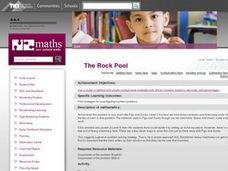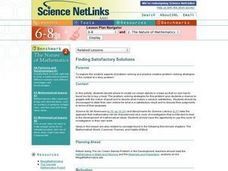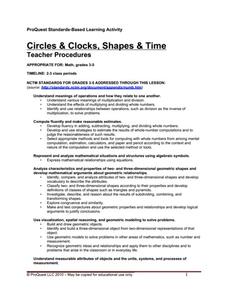Curated OER
Space Crossing
Learners critically follow a chain of reasoning to devise a decent problem solving technique to be applied to a reasonable problem. They also examine how to use logical arguments.
Curated OER
Who Plays What?
Ninth graders divide in pairs 3 cards with the words possible, impossible and certain on them. Ask questions of the class and get the students to hold up the word that describes the event (for example) Tomorrow it will snow. You have...
Curated OER
My Son is Naughty
Students find factors of numbers; work systematically; and use logic to explain away certain possible number combinations. They then devise and use problem solving strategies to explore situations mathematically.
Curated OER
Divided We Stand
Students figure out how to arrange seating in a concert hall given specific requirements. They better explain how dividing can allow us to arrive at mathematical solutions quickly and logically.
Curated OER
Noughts
Students try to figure out the strategies to the game Noughts. Students logic must play a part in the process of the game. Students apply the symmetries of regular polygons. Students devise ways to critically follow a chain of reasoning.
Curated OER
Class Conscience
In this algebra worksheet, 10th graders rewrite algebraic expression using algebra. They follow specific steps to solve this word problem. There is an answer key.
Curated OER
The Rock Pool
Third graders use number sense and appropriate problem solving techniques to solve the assigned problems. They write out the solutions to the assigned problems. They work in groups to solve the problem before reporting back to the whole...
Curated OER
Finding Satisfactory Solutions
Students explore the creative aspects of problem-solving and practice creative problem-solving strategies in the context of a story problem. They decide where to locate ice cream stands in a town so that no one has to travel too far to...
Curated OER
Circles and Clocks, Shapes and Time
Students work in groups to research clocks and practice telling time. For this telling time lesson, students use the computer program ProQuest to study circles, including radius and diameter, and practice drawing circles using a compass....
Curated OER
Sorting
Students explore how to logically sort and store information in order to make it easy to manage and easily retrieved. They explore methods they can use to organize and manage information.
Curated OER
The Fourth Quadrant of Proportiona
Students experiment with scale to solve a problem presented in a video clip. They determine the correct size to use when constructing a model and evaluate the use of proportions in real life applications.
Curated OER
Property Lists for Quadrilaterals
Young scholars establish classifications of shapes by various properties (angles, sides, etc.). They introduce the important properties of common shapes. Students develop an awareness of the wide variety of ways the 2-D shapes can be alike.
Curated OER
Triangle Inequality
Students discover that the sum of the lengths of any two sides of a triangle must be greater than the third side. They are shown how a triangle is formed using three strips such as that the triangle is seen inside the strips.
Illustrative Mathematics
Comparing Rational and Irrational Number
Algebra learners must know how to use rational numbers to approximate irrationals. This resource asks participants to decide which number is larger without using a calculator. It makes a great exercise to use as a five-minute transition...
Curated OER
Getting to the Bottom of the Pyramids
Students work together to develop logical arguments about pyramids and chain letters. They share their ideas with other groups and create a diagram showing the breakdown. They discuss the results.
Curated OER
The Farmer's Sheep
Students use problem solving skills, logical thinking, and their ability to work sequentially in order to solve an algebra problem. They listen to the problem read aloud by the teacher and devise a plan in order to solve the problem.
Curated OER
Patterns
Second graders create an ABAB pattern with their name. In this early elementary math instructional activity, 2nd graders first model their names in an ABAB pattern with unifix cubes. They then recreate the pattern using letter stamps on...
Curated OER
Venn Diagram with Blocks
Fifth graders classify blocks according to their attributes. In this math lesson, 5th graders will identify attributes of blocks, sort them, then form the groups into a Venn Diagram, and write ratios using the attributes.
Curated OER
Missing Square
In this missing square worksheet, students find the missing square amongst a group of numbers with the number that logically belongs there. Students complete 1 problem.
Curated OER
Bubblegum balls
Learners look for patterns to solve problems involving statistics using different colored gumballs. They should be able to look for and find out all the possible outcomes based upon inference and trials.
Curated OER
Weighing Time
Young scholars devise a strategy to solve problems that is done in a systematic and mathematical fashion. The finding of the unknown value is the focus of the lesson. To solve linear equations proficiently is the skill of the lesson.
Curated OER
That's Not Fair
Fourth graders in pairs, go to the front of the class, where one student is given five pieces of candy in one hand and four in the other. The other student is given four candies in one hand and none in the other. They discuss if they...
Curated OER
Strawberry Milk
Students work in groups or alone to solve the problem. They use a systematic approach to get all possible answers. They report back to the class with solutions. They may extend their studying using a crate with room for 9 bottles.

























